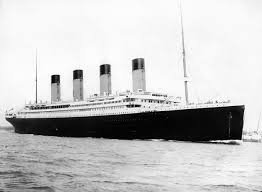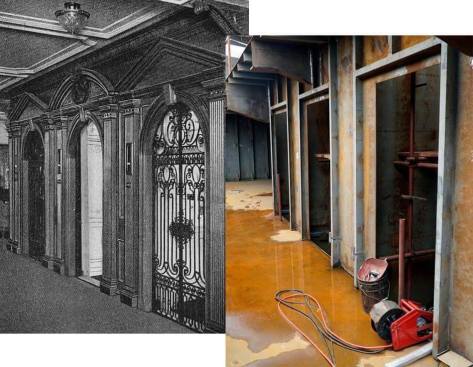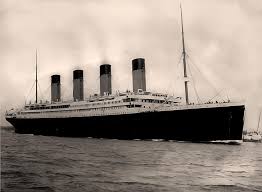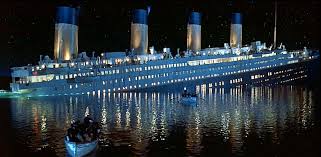
The image alone is powerful enough to generate appalled fascination, even after more than a century. The huge ocean liner, ablaze with light from bow to stern, racing across the calm, starlit ocean towards her chilling rendezvous near midnight. Her quartet of black and buff smokestacks standing like the ramparts of some castle, blotting out the very stars themselves in places. The strains of The Blue Danube floating out across the ocean, punctuated by the random popping of champagne corks and sudden, swelling bursts of laughter from on board.
These last, living images of RMS Titanic are only part of the reason that her story refuses to sink. She sails on in our minds’ eye to this day; a sort of 21st century Flying Dutchman, with interiors by Cesar Ritz. Fuelled by a mixture of horror, fascination and sheer, fatal glamour, she charges heedlessly onward, sailing in search of an absolution that she can never, ever be gifted. Even now, humanity is still too deeply in her thrall to ever allow her to be truly at peace.
Her story is simply too fantastic and incredulous to take fully on board. The combined talents of Stephen King, Jules Verne, Gene Roddenberry and Hans Christian Andersen could never have concocted a fable so stark and unbelievable as the actual truth of what happened aboard the Titanic on that freezing April night in mid-Atlantic. It remains without equal in it’s scale; a ghastly black comedy played out to an audience of cold, pitiless stars.
It almost seems as if there are two ships called Titanic. There is the real ship, the one that ripped her hull open on a capsized iceberg, and then succumbed to a fatal ingress of water, and then there is the Titanic of myth and legend; the ‘Floating Ritz’ that sails on to this day. Sometimes it is hard to know just where one ends, and the other truly begins.
Some of the myths are actually pretty easy to debunk. Far from being some unique, luxurious freak ship, Titanic was actually the second of a trio that were intended to be world beaters. Her almost identical sister ship- the Olympic- had already been in service for a full ten months. And, just thirteen months after her loss, Germany’s Hamburg America Line introduced the even larger Imperator. Had she survived her maiden voyage, Titanic would thus have been the world’s largest ship for little over a year.
No, it was not so much the ship herself alone that created the myth, though she was certainly spectacular enough. In first class at least, the Titanic was staffed- and ran- like the Ritz. The opulence was as full blown as could be; a true Hollywood movie set on the ocean, created years before the ‘talkies’ were even invented.
That luxurious glut, when coupled to her platinum chip, first class passenger list, accounts for a huge part of her legendary lore. Many of those first class passengers were household names the world over. Bankers and railroad owners. Famous socialites, writers and politicians. World renowned sports stars and sirens of the silent screen. And many of them would go to the bottom with the ship; unwitting bit part players in the most glittering and tragic curtain call in maritime history.
Everything about the Titanic was extreme, from her monumental dimensions right down to her mind blowing, spectacular demise. She became a stage upon which heroes were created, and where villains exited stage left to a conga line chorus of boos, hissing and catcalls. Even now, the lines between the two are as finely drawn as those original architect’s blueprints of the ship herself.
Of course, we have the ship’s band, sawing gamely away at dance music as their own, slim chances of survival receded further with each fading note. There’s Phillips and Bride in the wireless room, sending their increasingly desperate distress calls spluttering vainly through the ether. And the engineers, toiling manfully far below on the ominously sloping decks, trying to keep the lights and wireless operating for as long as humanly possible. There are so many more, and too many of them that will remain forever unsung, their selfless deeds cloaked in the darkness of the ship that carried them to their deaths.
And there are the villains, too. Step forward, J. Bruce Ismay, the fastidious control freak who was chairman of the White Star Line. He left the Titanic in one of the very last lifeboats while his officers, together with hundreds of other men, stood back, grim faced and ashen as they fought to keep their self control in the face of the obvious, encroaching catastrophe that would soon overwhelm them.
He’s an easy target, is Bruce Ismay; even more so, when you consider that it was he who vetoed the idea of scores of extra lifeboats for the Titanic in the first place. Whether those same, imaginary boats could even have been safely loaded, and then lowered into the water given the short amount of time the iceberg gifted to the Titanic, is strangely academical.
I mean, compare Ismay’s cartoon villain chicanery to the gallant Captain Edward Smith, who of course went down with his ship. The fact that Captain Smith was no more effective in evacuating Titanic than the hapless Francesco Schettino would be in the same position aboard the Costa Concordia almost exactly a century later- that gets overlooked. Because, of course, that’s the kind of thing that we expect from a hero. We expect them to die manfully, with a dash of tight lipped, stoic serenity where possible. We don’t want inconvenient facts getting in the way of that kind of posthumous, elevated effigy worship. If there are villains, then there must be heroes, too. It’s the same in any Greek tragedy.
And that, in a nutshell, is it. We all want answers to questions that can never be definitively resolved, because those with the ability to provide resolution mostly died with the ship, while those survivors with the ability to at least partly do so- certainly Bruce Ismay and, quite likely, Second Office Lightoller- stayed tight lipped until their eventual deaths.
In the case of Ismay, this reluctance to elaborate is at least understandable, but what was Lightoller’s play in all this? Again, in the absence of definitive information, we can but speculate.
Charles Lightoller was the senior surviving officer of the Titanic. He had been at the heart of everything that night. As well as being in charge of loading and lowering the port side lifeboats, he had also been on watch on the bridge just a few hours earlier, before handing the watch over to First Officer Bill Murdoch.
Lightoller- as well as Murdoch-toiled manfully to get those boats away that night. But Lightoller interpreted Captain Smith’s order of ‘women and children first’ as ‘women and children only’ whereas Murdoch, in charge of the starboard side boats, allowed men into the boats when no more women and children were in sight.
Thus, what happened on one side of the ship did not transpire on the other when the botched evacuation finally swung into full, frantic gear. Of the 705 survivors of the Titanic, a full seventy-five per cent left in boats lowered under Murdoch’s auspices.
Lightoller- as brave a man as ever there was on the ship that night- intended to stay with the White Star Line. He had hopes of eventually becoming a ship’s captain himself and, just prior to the disaster, he almost certainly would have done in the normal scheme of things. But, after the Titanic, nothing would ever be normal again.
At the subsequent inquiries into the disaster held in both Washington and London, Charles Lightoller played a tight batting game; adroitly side stepping questions when needed, and taking full advantage of the questioning attorneys’ relative ignorance of maritime affairs. With his professional future well and truly in the cross hairs, Lightoller fought manfully to absolve the White Star Line of any responsibility for the loss of the Titanic. And the heroic, totally credible Second Officer made for the kind of witness that no-one truly wanted to pressure, let alone contradict. In terms of defending his employers, Charles Lightoller played an absolute blinder.
Lightoller was also resolute in defending the posthumous memory of Captain Smith, whom he had almost idolized as a skipper. But his dedication to both causes served him ill.
For the White Star Line wanted to whitewash the Titanic from memory, and that meant a stealthy, utterly ruthless removal of anyone even remotely connected with her. Bruce Ismay was forced to resign as chairman within eighteen months and Lightoller, fine sailor that he was, never, ever got a command of his own. Indeed, none of her four senior, surviving officers ever did.
But that loss of lives undoubtedly haunted Lightoller. In May of 1940, when the British Army found itself with its back to the sea in the port of Dunkirk, Charles Lightoller was one of hundreds of retired seaman who answered his country’s call in its ‘darkest hour’.
He took is own launch, Sundowner, over the channel to the beach at Dunkirk. Despite frequent bombing and terrifying machine gun attacks, Lightoller and his makeshift crew worked like Trojans to rescue as many of the sodden, demoralised survivors of the BEF as possible. That his actions saved many lives is beyond doubt, as is the fact that he put himself in great peril by so doing.
Of course, Charles Lightoller would have simply dismissed such heroics as ‘doing his duty’ like hundreds of his fellow sailors did.
But you have to at least concede that his actions were probably influenced by a desire to try and make up for those lost in the botched evacuation of the Titanic, some twenty-eight years earlier. Survivor’s guilt is a proven syndrome of maritime catastrophes, and no-one was more acutely aware of all those empty places in the port side Titanic lifeboats than Charles Lightoller.
So. Titanic. Everyone’s a genius and, of course, hindsight is the greatest gift to humanity since radar. We’re all so, so certain that we know just what happened; just as certain as those officers on the bridge of the Titanic themselves were on that cold April night in mid Atlantic, all those years ago.
In the absence of certainty then, we have an enigma. An elegant, deathless enigma that continues to astound, appal and amaze all those who come aboard for the voyage.
It’s an endless voyage across an otherwise empty, mostly ethereal ocean of memories and mystery, aboard a ship of the dead that never truly learned how to sail, or even how to really die, for that matter.



